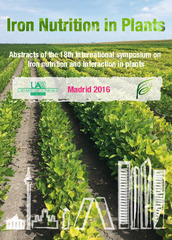Приказ основних података о документу
SILICON ENHANCES NICOTIANAMINE•MEDIATED IRON TRANSPORT IN CUCUMBER LEAVES
| dc.creator | Pavlović, Jelena | |
| dc.creator | Nikolic, Miroslav | |
| dc.date.accessioned | 2023-11-28T18:35:51Z | |
| dc.date.available | 2023-11-28T18:35:51Z | |
| dc.date.issued | 2016 | |
| dc.identifier.isbn | 13978- 84-608- 8263-3 | |
| dc.identifier.uri | http://rimsi.imsi.bg.ac.rs/handle/123456789/2455 | |
| dc.description.abstract | Silicon (Si) and iron (Fe) are the second and the fourth most abundant minerals respectively in the earth’s crust. While the essentiality of Fe for plants was discovered in the middle of the 19th century, Si is still not accepted as an essential element. However, its beneficial effect on plant growth and development, especially under stress conditions, is well documented in the literature. As a consequence of poor Fe availability for higher plants, especially in alkaline and calcareous soils, Fe deficiency represents a major nutritional disorder responsible for reduction in both yield and quality of a wide range of crops. Iron deficiency in crops has thus a strong negative impact on human health worldwide. Retranslocation of iron (Fe) from source tissues enhances plant tolerance to Fe-deficiency. Here we investigated the role of Si in Fe mobilization in older leaves and the subsequent retranslocation of Fe to young leaves of cucumber (Cucumis sativus) plants growing under Fe limiting conditions. We determined Fe (57Fe or naturally-occurring isotopes) in leaves at different positions on plants growing with or without Si supply. In parallel the content of the Fe chelator nicotianamine (NA) and the expression of nicotianamine synthase (NAS) involved in its biosynthesis were also measured. In plants not receiving Si, approximately half of the total Fe content remained in the oldest leaf. By contrast, Si-treated plants showed an almost even Fe distribution between leaves at four different developmental stages, thus providing evidence of enhanced Fe remobilization from source leaves. This stimulated Fe export was paralleled by increased NAS1 gene expression and NA content in expanded leaves of Si-supplied plants. In conclusion, our results for the first time show that Si induces Fe mobilization in older leaves and increases its retranslocation to younger expanding leaves. Supply of Si enhances expression of NAS1 gene responsible for NA biosynthesis and hence increased NA accumulation which in turn enhances chelation of Fe and phloem loading of Fe-NA in the source (expanded) leaves to facilitate phloem transport of Fe and enhanced phloem unloading of Fe in the sink (expanding) leaves. | sr |
| dc.language.iso | en | sr |
| dc.publisher | Department of Agricultural Chemistry and Food Sciences Faculty of Sciences University Autonoma of Madrid | sr |
| dc.rights | openAccess | sr |
| dc.rights.uri | https://creativecommons.org/licenses/by/4.0/ | |
| dc.source | Abstracts of the 18th International Symposium on Iron Nutrition and Interaction in Plants May 30th – June 3rd, 2016, Madrid, Spain | sr |
| dc.subject | iron retranslocation, leaves, nicotianamine, nicotianamine synthase (NAS), phloem transport, silicon | sr |
| dc.title | SILICON ENHANCES NICOTIANAMINE•MEDIATED IRON TRANSPORT IN CUCUMBER LEAVES | sr |
| dc.type | conferenceObject | sr |
| dc.rights.license | BY | sr |
| dc.identifier.fulltext | http://rimsi.imsi.bg.ac.rs/bitstream/id/6361/bitstream_6361.pdf | |
| dc.identifier.rcub | https://hdl.handle.net/21.15107/rcub_rimsi_2455 | |
| dc.type.version | publishedVersion | sr |

